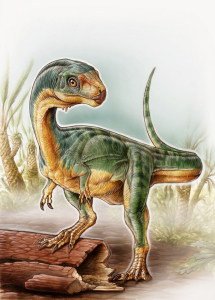
It doesn’t resemble a platypus, but the newest species of theropod — the dinosaur group that included Velociraptor and Tyrannosaurus and evolved into modern birds — is a similarly confusing hodgepodge of dino qualities.
For starters, Chilesaurus diegosuarezi went veg way back 145 million years ago when all of its relatives were still meat eaters. Until now, researchers hadn’t seen an herbivorous theropod until much closer to modern birds on the evolutionary timeline. The meatless diegosuarezi is described in a paper published Monday in the journal Nature.
When researchers first examined a specimen of the platypus, they thought it must be fake. It looked too much like someone had simply sewn together a beaver and a duck, showing obvious characteristics of two completely different animals.
Similarly, researchers initially thought the bones of Chilesaurus diegosuarezi must belong to multiple species.
Chilesaurus diegosuarezi is named in honor of Diego Suárez, who found the first bone remains in the Toqui Formation in Chile at the age of 7 while out with his geologist parents. But since that first discovery, researchers have found enough additional bones — including four complete skeletons, most about the size of a turkey — to conclude that the mish-mash of parts belonged to one creature.
The dinosaurs would have had big forelimbs like the Allosaurus with two blunt fingers at the end instead of claws. But its pelvis shape, small skull and some other bones resemble totally different groups of dinosaurs, suggesting an herbivorous lifestyle that evolved in theropods independently of these other groups.
” Chilesaurus can be considered a ‘platypus’ dinosaur because different parts of its body resemble those of other dinosaur groups due to mosaic convergent evolution,” study author Martín Ezcurra of the University of Birmingham said in a statement. “In this process, a region or regions of an organism resemble others of unrelated species because of a similar mode of life and evolutionary pressures. Chilesaurus provides a good example of how evolution works in deep time and it is one of the most interesting cases of convergent evolution documented in the history of life.”
It’s a reminder, he said, that researchers should be careful not to group extinct species together by similarities in form alone. Just weeks ago, another research group announced that the Brontosaurus, which had been deleted as a genus because of its apparent similarities to an earlier described one, actually has enough differences to be reinstated. It’s hard to classify cousins that lived 150 million years ago, but thanks to new techniques paleontologists are getting better at it all the time.
© 2015, The Washington Post





